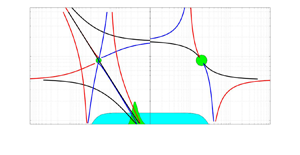Published online by Cambridge University Press: 24 May 2024

Wave turbulence provides a conceptual framework for weakly nonlinear interactions in dispersive media. Dating from five decades ago, applications of wave turbulence theory to oceanic internal waves assigned a leading-order role to interactions characterized by a near equivalence between the group velocity of high-frequency internal waves with the phase velocity of near-inertial waves. This scale-separated interaction leads to a Fokker–Planck (generalized diffusion) equation. More recently, starting four decades ago, this scale-separated paradigm has been investigated using ray tracing methods. These ray methods characterize spectral transport of energy by counting the amplitude and net velocity of wave packets in phase space past a high-wavenumber gate prior to ‘breaking’. This explicitly advective characterization is based on an intuitive assignment and lacks theoretical underpinning. When one takes an estimate of the net spectral drift from the wave turbulence derivation and makes the corresponding assessment, one obtains a prediction of spectral transport that is an order of magnitude larger than either observations or reported ray tracing estimates. Motivated by this contradiction, we report two parallel derivations for transport equations describing the refraction of high-frequency internal waves in a sea of random inertial waves. The first uses standard wave turbulence techniques and the second is an ensemble-averaged packet transport equation characterized by the dispersion of wave packets about a mean drift in the spectral domain. The ensemble-averaged transport equation for ray tracing differs in that it contains the intuitively motivated advective term. We conclude that the aforementioned contradiction between theory, numerics and observations needs to be taken at face value and present a pathway for resolving this contradiction.